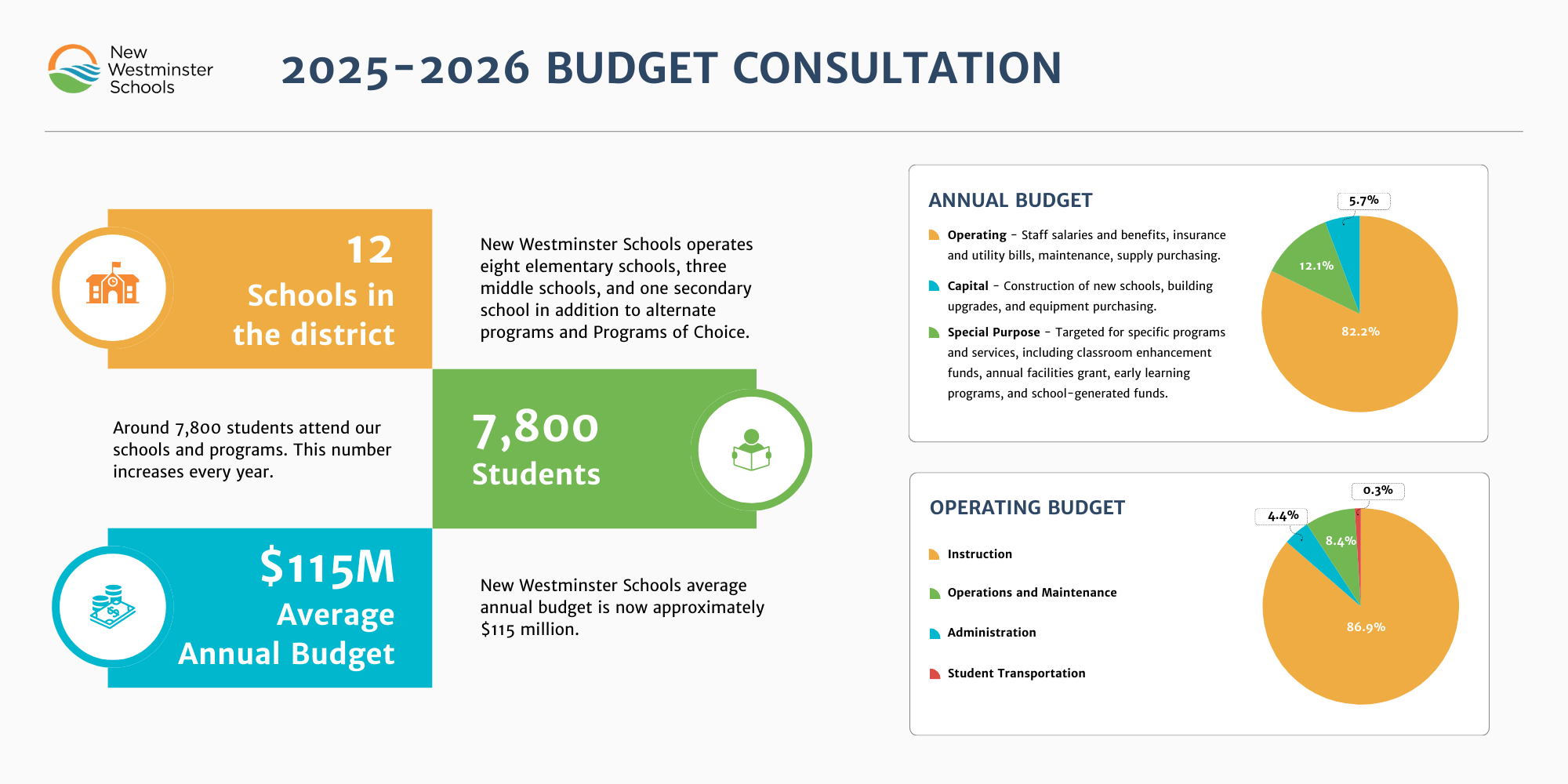
2025-2026 budget consultation
New Westminster Schools’ budget consultation for the 2025-2026 school year is now active.
Your input is very important to us and will help our district determine spending priorities. You can share your feedback through our online budget survey starting February 10 at 10 a.m. and closing on February 21 at midnight (12 a.m.).
Structural deficit in 2025-2026
New Westminster Schools is facing a “structural deficit” as we head into the 2025-26 school year. This is important context to keep in mind for this year’s consultation.
What is a structural deficit?
Structural deficits happen when the amount of funding generated by our district isn’t enough to cover every budget expense.
Why do we have a structural deficit?
Reasons for our structural deficit include, but are not limited to:
- Sustaining programs and student services that do not have a funding source or that rely on surplus funds.
- Exempt staff and collective agreement wage lifts not fully funded by the government over time.
- Fewer students coming to New Westminster Schools through the International Student Program (as tuition paying learners) to make space for local enrolment.
- High enrolment growth and the need to purchase many portables out of operating grants.
- Higher costs of maintaining aged buildings and facilities.
- Lack of funding to keep up with inflation.
What does this mean for New Westminster Schools?
In previous years, district services and initiatives that were not fully funded through the regular budget were maintained with accumulated surplus money. These funds can only be used once and not continually to balance the annual budget.
Surplus balances are no longer available, as they were spent last year. In accordance with Policy 19 Financial Reserves, the Board of Education will have to develop a plan to restore balances to a base level.
To address the deficit, immediate and long-term changes and restructuring of operations and related costs are necessary. These changes must start next school year to ensure our financial stability in the present and future.
What our budget funds

Annual budgets
Each year, we work on budget proposals for the Board of Education’s consideration and approval. The process involves reviewing our priority assessments (based on our five-year strategic plan) and current and future needs with input from interested parties.
These deliberations help inform the superintendent’s recommendations to the Board of Education on the approval of the budget for the upcoming school year.
About the district budget
Building school budgets is about setting priorities around how to achieve goals that help support students, staff, and our community.
Consulting with our community and various interested parties helped us create our five-year strategic plan. Thanks to that work, we’re taking the next step from collecting and understanding priorities to making sure we have the resources to act on them in a meaningful way.
Because needs and priorities evolve over time, we will occasionally need to make budget adjustments based on factors like:
- Changes to student enrolment and funding provided from the provincial government.
- Changes to staffing or school enrolment needs.
- Shifting departmental priorities, which align to the strategic plan.
- Key priorities or targeted projects for the current year.
Budgets and reports
Annual budgets
2024 – 2025
2023- 2024
2022-2023
2021-2022
2020-2021
Financial statements
2023 – 2024
- 2023-2024 Statement of Financial Information
- 2023-2024 Audited Financial Statements
- 2023-2024 Financial Statement Discussion and Analysis
2022-2023
- 2022-2023 Statement of Financial Information
- 2022-2023 Audited Financial Statements
- 2022-2023 Financial Statement Discussion and Analysis
2021-2022
- 2021-2022 Statement of Financial Information
- 2021-2022 Audited Financial Statements
- 2021-2022 Financial Statement Discussion and Analysis